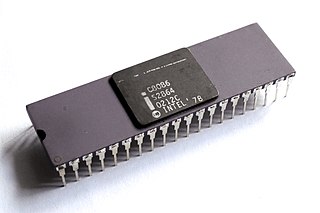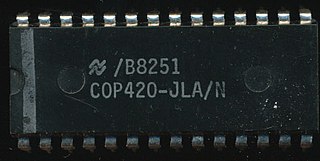The MOS Technology 6508 is an 8-bit microprocessor designed by MOS Technology. Based on the popular 6502, the 6508 is augmented with two additional features: an internal 8-bit digital I/O port and 256 bytes of internal static RAM.
Contents

The MOS Technology 6508 is an 8-bit microprocessor designed by MOS Technology. Based on the popular 6502, the 6508 is augmented with two additional features: an internal 8-bit digital I/O port and 256 bytes of internal static RAM.

The internal RAM is mapped into the CPU address space both at $0000-$00FF and at $0100-$01FF, so it can serve as both zero page and stack space. The I/O port is available at location $0001, with a data-direction register at $0000, which is the same layout of the 6510.

There may be different strapping/bonding variants of this chip; the datasheet below lists pin 40 as clock phase two, but in the CBM900 computer, the 6508 controlling floppydisk has pin 40 as "Set Overflow" (SO). SO is a pin that is also offered on the 40-pin 6502, but omitted on all the 28-pin 650x variants (6503–6507). The SO pin, on 6500 family CPUs that have it, sets the Overflow flag in the P register, which can be tested using BVC/BVS instructions. Using SO, a tight polling loop of 3 machine cycles can be constructed, tighter than the minimum two instructions of any test and branch loop not using the SO pin functionality.

The 8086 is a 16-bit microprocessor chip designed by Intel between early 1976 and June 8, 1978, when it was released. The Intel 8088, released July 1, 1979, is a slightly modified chip with an external 8-bit data bus, and is notable as the processor used in the original IBM PC design.

The Intel 8088 microprocessor is a variant of the Intel 8086. Introduced on June 1, 1979, the 8088 has an eight-bit external data bus instead of the 16-bit bus of the 8086. The 16-bit registers and the one megabyte address range are unchanged, however. In fact, according to the Intel documentation, the 8086 and 8088 have the same execution unit (EU)—only the bus interface unit (BIU) is different. The original IBM PC is based on the 8088, as are its clones.

The MOS Technology 6502 is an 8-bit microprocessor that was designed by a small team led by Chuck Peddle for MOS Technology. The design team had formerly worked at Motorola on the Motorola 6800 project; the 6502 is essentially a simplified, less expensive and faster version of that design.
The MOS Technology 65xx series is a family of 8-bit microprocessors from MOS Technology, based on the Motorola 6800. The 65xx family included the 6502, used in home computers such as the Commodore PET and VIC-20, the Apple II, the Atari 800, and the British BBC Micro.

The MOS Technology 6510 is an 8-bit microprocessor designed by MOS Technology. It is a modified form of the very successful 6502. The 6510 is widely used in the Commodore 64 (C64) home computer and its variants.

The Motorola 6809 ("sixty-eight-oh-nine") is an 8-bit microprocessor with some 16-bit features. It was designed by Motorola's Terry Ritter and Joel Boney and introduced in 1978. Although source compatible with the earlier Motorola 6800, the 6809 offered significant improvements over it and 8-bit contemporaries like the MOS Technology 6502, including a hardware multiplication instruction, 16-bit arithmetic, system and user stack registers allowing re-entrant code, improved interrupts, position-independent code and an orthogonal instruction set architecture with a comprehensive set of addressing modes.

MOS Technology, Inc., later known as CSG , was a semiconductor design and fabrication company based in Audubon, Pennsylvania. It is most famous for its 6502 microprocessor and various designs for Commodore International's range of home computers.

The Z80 is an 8-bit microprocessor introduced by Zilog as the startup company's first product. The Z80 was conceived by Federico Faggin in late 1974 and developed by him and his 11 employees starting in early 1975. The first working samples were delivered in March 1976, and it was officially introduced on the market in July 1976. With the revenue from the Z80, the company built its own chip factories and grew to over a thousand employees over the following two years.
In computer architecture, 8-bit integers or other data units are those that are 8 bits wide. Also, 8-bit central processing unit (CPU) and arithmetic logic unit (ALU) architectures are those that are based on registers or data buses of that size. Memory addresses for 8-bit CPUs are generally larger than 8-bit, usually 16-bit. 8-bit microcomputers are microcomputers that use 8-bit microprocessors.

The 6507 is an 8-bit microprocessor from MOS Technology, Inc. It is a version of their 6502 packaged in a 28-pin DIP, which makes it cheaper to package and integrate in systems. The reduction in pin count is achieved by reducing the address bus from 16 bits to 13 and removing a number of other pins used only for certain applications.

The Intel 8085 ("eighty-eighty-five") is an 8-bit microprocessor produced by Intel and introduced in March 1976. It is software-binary compatible with the more-famous Intel 8080 with only two minor instructions added to support its added interrupt and serial input/output features. However, it requires less support circuitry, allowing simpler and less expensive microcomputer systems to be built.

The VIC-II, specifically known as the MOS Technology 6567/8562/8564, 6569/8565/8566 (PAL), is the microchip tasked with generating Y/C video signals and DRAM refresh signals in the Commodore 64 and C128 home computers.

The COSMAC is an 8-bit microprocessor family introduced by RCA. It is historically notable as the first CMOS microprocessor. The first production model was the two-chip CDP1801R and CDP1801U, which were later combined into the single-chip CDP1802. The 1802 represented the majority of COSMAC production, and today the entire line is known simply as the RCA 1802.

The MOS Technology 8502 is an 8-bit microprocessor designed by MOS Technology and used in the Commodore 128 (C128). It is an improved version of the MOS 6510 used in the Commodore 64 (C64). It was manufactured using the HMOS process, allowing it to have higher transistor density, and lower cost, while dissipating less heat. The 8502 allows the C128 to run at double the clock rate of the C64 with some limitations.
The zero page or base page is the block of memory at the very beginning of a computer's address space; that is, the page whose starting address is zero. The size of a page depends on the context, and the significance of zero page memory versus higher addressed memory is highly dependent on machine architecture. For example, the Motorola 6800 and MOS Technology 6502 processor families treat the first 256 bytes of memory specially, whereas many other processors do not.
The 6800 family of 8-bit microprocessors (µPs) and microcontrollers (µCs) is based upon the Motorola 6800 CPU. The architecture also inspired the MOS Technology 6502, and that company started in the microprocessor business producing 6800 replacements.

The Western Design Center (WDC) 65C02 microprocessor is an enhanced CMOS version of the popular nMOS-based 8-bit MOS Technology 6502. The 65C02 fixed several problems in the original 6502 and added some new instructions, but its main feature was greatly lowered power usage, on the order of 10 to 20 times less than the original 6502 running at the same speed. The reduced power consumption made the 65C02 useful in portable computer roles and microcontroller systems in industrial settings. It has been used in some home computers, as well as in embedded applications, including medical-grade implanted devices.
The Mitsubishi 740, also known as MELPS 740, is a series of 8-bit CMOS microcontrollers and microprocessors with an enhanced MOS Technology 6502 compatible core based on the expanded WDC 65C02. The ICs were manufactured by Mitsubishi Electric during the 1980s and 1990s.

The W65C816S is an 8/16-bit microprocessor (MPU) developed and sold by the Western Design Center (WDC). Introduced in 1985, the W65C816S is an enhanced version of the WDC 65C02 8-bit MPU, itself a CMOS enhancement of the venerable MOS Technology 6502 NMOS MPU. The 65C816 was the CPU for the Apple IIGS and, in modified form, the Super Nintendo Entertainment System.

The COP400 or COP II is a 4-bit microcontroller family introduced in 1977 by National Semiconductor as a follow-on product to their original PMOS COP microcontroller. COP400 family members are complete microcomputers containing internal timing, logic, ROM, RAM, and I/O necessary to implement dedicated controllers. Some COP400 devices were second-sourced by Western Digital as the WD4200 family.